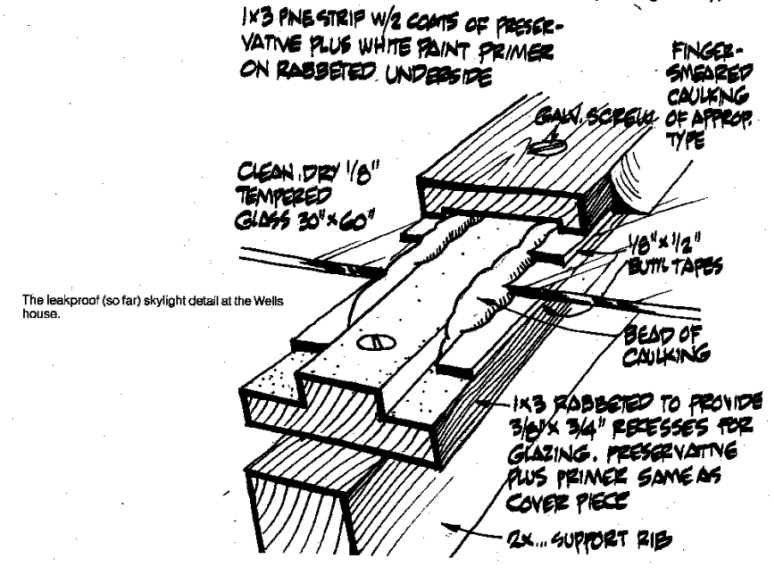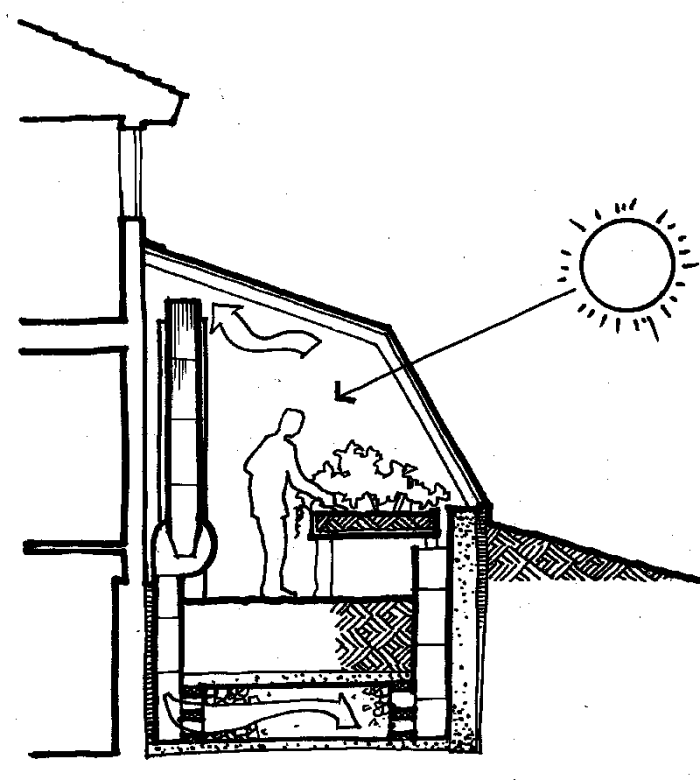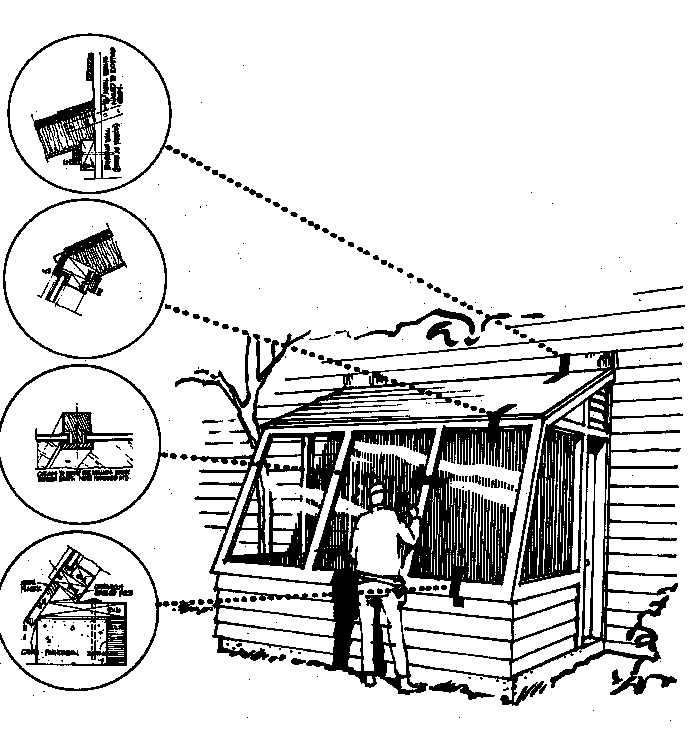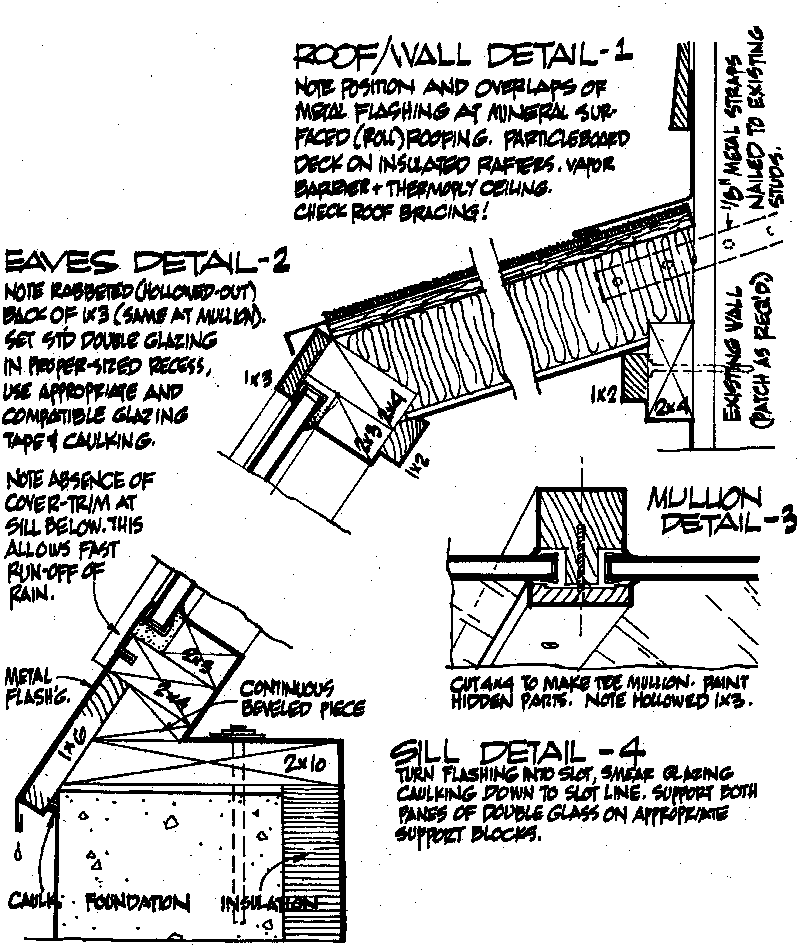what type of tile to use in a passive solar sunspace
Solar Rooms -- from Passive Solar Energy Book
| This is the section of the book Passive Solar Energy by Bruce Anderson and Malcolm Wells that deals with solar rooms, sunspaces and greenhouses. It includes solar room ideas and blueprint data, as well equally construction drawings and some case photos of solar rooms. This material is made available through the generosity of the authors. The unabridged volume, covering many aspects of passive solar energy can be downloaded here. |

Without ventilation or thermal mass, the temperatures of spaces having large areas of south-facing windows will fluctuate widely. Temperatures of conventional not-solar greenhouses, for example, can rising to over 100� on sunny wintertime days and and then driblet to below freezing at night. If a sun heated room is permitted to have wider-than-normal temperature fluctuation, then the costs of thermal mass (to store heat) and movable insulation (to reduce heat loss) are avoided. The excess warmth from such a "solar room" can heat the house immediately, or if mass is added, heat can be stored for later use later the sun sets. Almost always, the solar room is warmer than the outdoor temperature, thus reducing estrus loss from the building where the room is fastened. Examples of solar rooms include greenhouses, solariums, and lord's day porches.
Greenhouses are the most common solar rooms. Conventional greenhouses, however, are not designed to accept maximum reward of the sun'southward energy. The problem is that most are built with a single layer of glass, and then they lose more than estrus at night than they gain from the sunday during the day. Consequently, they need expensive auxiliary heat to keep the plants warm.
A solar greenhouse is designed both to maximize solar gain and to minimize heat loss. Commonly, only the s facing walls and roof of the solar greenhouses are glazed, while the east and w walls are well-insulated. (Southeast and southwest portions, if whatsoever, are also glazed, partly because plants need that low-angle early sunlight.) If at least two layers of glass or plastic are used instead of one, this type of greenhouse will remain above freezing most of the wintertime in all only the coldest climates of this country. All the same, for maximum oestrus savings while growing plants year round, three and even four layers of drinking glass and plastic should be used where winters have more than than 5000 degree days. Keep in mind that each boosted layer of glazing blocks boosted sunlight. Therefore, for the highest possible calorie-free manual, the third and fourth layers must be a very clear flick, such equally Teflon� or Tedlar�. Each layer must be sealed tightly to prevent structural damage from possible moisture condensation between glazing.
For maximum sunshine, and for minimum heat loss at night, movable insulation is used in combination with double glazing. This tin be tough to do, all the same. Some of the tricky pattern and construction problems include storing the insulation out of the fashion during the day, interfering with plants while moving the insulation, and obtaining tight seals against the glazing when the insulation is closed. Additional considerations include the need for insulation to resist mold, other constitute and insect life, and wet damage.
Glazing for solar rooms should be vertical or sloped no more than 30� from vertical (at least 60� from horizontal). Before yous build, nevertheless, talk to everyone you tin observe who has ever used glass in a sloping position, and ask most leaks. If you lot tin can find someone who can convince yous of a leak proof system, do not let any details escape your attention. Likewise, read the fine print in the sealants literature. Some silicones are attacked by mildew, many won't stick to forest, and all must be practical merely to super clean surfaces.

Which Management?
Solar rooms that face up due east or due west practice not piece of work besides for heating equally those that face south. The former supply less heat during the winter and may provide much too much in summer. However, an east-facing greenhouse can requite morning light, which plants like; it can be a buffer zone to reduce heat loss from the business firm throughout the residuum of the day. If an e-facing solar room seems to be a proficient solution to either site or building problems, locate spaces such as kitchens on the east side of the house next to or behind the solar room to take reward of the morning time calorie-free and heat. Then the living rooms and bedrooms, which can usually remain cool during the day, will become warm in the afternoon from the oestrus gained fro
Rut Storage
As with other passive systems, thermal mass enhances the performance of a solar room. Thermal storage mass moderates temperature swings, provides more than stable growing temperatures for plants, and increases overall heating efficiency. The heat-storing capability of the planting beds tin be supplemented with 55-gallon drums, plastic jugs, or other containers of water. Two to four gallons of h2o per square foot of glazing is probably adequate for most solar rooms.
Many of the near successful solar rooms are separated from the firm by a heavy wall that stores the oestrus. The wall, built of concrete, stone, brick, or adobe, conducts oestrus (slowly) into the house. At the aforementioned time, the wall keeps the solar room cooler during the day and warmer at night. Use the design and construction information for solar walls, but eliminate the glazing.
World, physical, or the floors store considerable heat. So practice foundation walls if insulated on the outside. Exist sure to use insulation with an R-value of at least 12 (iii inches of Styrofoam�). Insulate at least three to 4 feet deep and more in deep-frost country. This gives improve protection than insulating 2 feet or so horizontally under the floor
When solar rooms larger than 200 square anxiety achieve xc�, a fan can exist used to circulate the collected heat. Because plants do good from having warm soil, hot air tin be diddled horizontally through a 2-foot-deep bed of stones below the greenhouse floor or under raised planting beds. Stone beds can also be built beneath the floor of the house and should not be insulated from information technology. And then the heat volition rise naturally through the rock beds and into the planting bed soil or into the firm.
Two cubic feet of ordinary washed stone per foursquare foot of glazing is sufficient. Use a fan capable of moving about 10 cubic feet of air per minute for each square foot of glazing. Potato-sized stones, larger than the usual 3/4 inch to 1 i/ii inch size, will permit freer air movement. Consult with a local mechanical engineer or heating contractor for the all-time fan and ducting pattern. (Proceed it unproblematic!)

Costs
Solar rooms tin be relatively simple to build, all the same they can be very expensive if they are of the same quality and durability as the rest of your house. For example, with a few hundred dollars worth of materials, you can build a elementary, woods-framed addition to your house to back up thin-pic plastics. The resulting enclosure will provide considerable heat, especially if it is not used for growing plants. On the other manus, good craftsmanship and quality materials can result in costs of several chiliad dollars. In general, solar rooms are most economical when you lot can utilise them for more than than providing heat and when they are built to a quality that will both heighten the value of your house and capeesh in value as your house does. Solar rooms are often exempt from local holding taxes. Check with your local officials.
Large Solar Rooms
Nearly of the information in this chapter is applicable for relatively small solar rooms of 100 to 200 square feet. Unless your house is super insulated or in a mild climate, a solar room of this size volition provide less than 25 percent of your heat. For large leaky houses, small solar rooms will provide equally lilliputian equally 5 or 10 percent of the heat.
Another way of budgeted the use of solar rooms to oestrus your house is to think of them as rather large spaces that are incorporated into, rather than attached onto, your house. There are a number of advantages with this approach:
Both the solar room and house volition lose less rut.
Heat will movement easily from the solar room to your firm.
Natural calorie-free can exist made to penetrate deep into your business firm.
The solar room can be easily heated by the house if necessary and then is unlikely to freeze.
The solar room can be readily used every bit an expanded living space.
You lot can build your firm compactly and the solar room will provide a feeling of large exterior wall and window expanse.
Growing Plants; Some things to remember
Growing Plants; some things to remember An important role of some solar rooms is the growing of food-and flowers. Warm soil and sufficient lite are critical for successful found growth. Think that the multiple layers of glass or plastic you may need to use will reduce light levels, a crucial issue in climates with below-average sunshine. Apportionment of warm air through gravel beds nether the soil tin raise planting bed temperatures, increasing the growth rate of nearly plants.
Cold atmospheric condition plants, such equally cabbage, can tolerate cold temperatures, sometimes even mildly-freezing ones. Few business firm plants tin can be permitted to freeze, but many can endure rather cool temperatures. On the other manus, some plants, such equally orchids, require stable, loftier temperatures. When warm, stable temperatures are required, the solar room must retain most of its solar heat; picayune heat should be allowed to motion into the house. Three or four layers of glass or plastic (or movable insulation) and enough of thermal mass are required to trap and comprise the heat in cold climates.
Evaporation of h2o from planting beds and transpiration by the plants causes humidity. Each gallon of h2o thus vaporized used roughly 8000 Btus, nearly the same amount of free energy supplied by 5 foursquare feet of glass on a sunny day. Also, water vaporization reduces peak temperatures. It may exist undesirable to circulate moisture-laden air into the house, unless the house is very dry.
Greenhouse environments are rather complex ecological systems. Unexpected and sometimes undesirable plant and animal growth may proliferate. Indications are that the greater mix of plants and animals, the more likely a natural remainder will eventually be reached. To obtain this residual, some owners leave the door of their solar room open to the outside during the warm and mild weather.
New Alchemy Establish, among others, has pioneered piece of work in natural pest command and companion planting as a step toward success�ful greenhouse direction. They have likewise investigated fish-raising in large "aquariums," which likewise serve as thermal mass. Human, brute, and/or plant wastes are integrated into the total ecology of many avant-garde greenhouses, which are sometimes referred to as bioshelters. A more thorough understanding of the many natural cycles that are possible in greenhouses will offer rewards.
Photos of Some Case Solar Rooms
Hither are photos of several different types of solar rooms, including sunspaces, solar porches, and greenhouses.
Construction Details for Solar Rooms
This solar greenhouse uses stock size insulated glass patio door unit s the solar aperture. These units are field-mounted in the wood-framed construction which rests on an added foundation wall of poured concrete or block and which is attached to the existing house wall by 2x4 braces and a 2x4ledger strip bolted to the wall. The side wall can be either clapboard or other siding to match the house. In this design, the two-inch beadboard foundation insulation is located on the within of the foundation wall to make a weatherproof exterior with no additional finishing required. All optional roll-downwards insulating curtain is included at the sloped glazing. (Construction details, New England SUEDE.)


Source: https://www.builditsolar.com/Projects/Sunspace/SolarRooms/SolarRooms.htm
0 Response to "what type of tile to use in a passive solar sunspace"
Enregistrer un commentaire